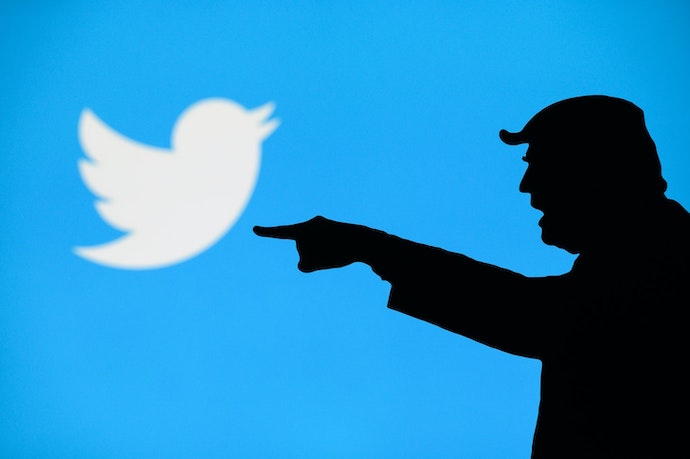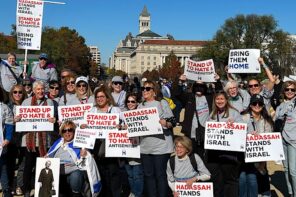When Twitter and Facebook shuttered the account of Donald Trump, along with thousands of others for allegedly spreading far right violence and conspiracy theories, many felt that it was long overdue. Antifascist organizers and writers, myself included, have for years argued against giving platforms to white supremacists, including powerful public figures. Following the Capitol Hill riot, many liberal commentators seemed to draw the same conclusion.
But the swift post-riot wave of deplatforming drew censure, too. The most compelling criticisms highlighted the troubling fact that a few Silicon Valley leviathans maintain unbridled and undemocratic power over access to major sites of public speech.
Both responses seem right to me. I can see the necessity of breaking up—and putting under greater democratic and worker control—the oligarchies of technocapital. And I can, at the same time, see a need to disrupt the production and continuance of racist far-right lifeworlds, which have flourished unchecked across social media.
Much digital ink has already been spilled on what sort of existing and possible regulation should be employed to curb the hegemonic control of a handful of tech giants. Fraught but crucial debates are also ongoing about social media platforms’ responsibilities and liabilities as regards racist, mendacious user content—a welcome shift after such debates had, for years, primarily focused on the blanket banning of sex workers from online platforms, imperiling their lives and livelihoods.
The issue of who has the power to grant or remove access to platforms, and according to which principles, is no doubt critical.
My interest here is a little different: it seems clear to me that even in a world of reconfigured social media, with power dramatically redistributed—a situation hard to imagine under contemporary capitalism, but bear with me—questions will persist around what sort of speech or speakers should be permitted on such platforms. These are sites which are public facing yet freer than the state to determine the limits of acceptable speech in the online worlds they host, and the material realities those worlds in turn produce. Much as, on a smaller scale, questions remain unsettled as to the ethics of giving platforms for far-right figures and politicians to publish and speak in given cultural establishments, news publications and universities.
We are poorly prepared to confront these questions if the popular discourse around deplatforming, free speech, alleged censorship, or so-called “cancel culture” remains so mired—as I believe it has long been—in inadequate philosophies of speech and language.
While certain corners of legal scholarship have addressed with nuance the ways in which speech and meaning function in the world, and how this should inform interpretations of the First Amendment, the current media and political discourse around deplatforming and free speech consistently fails to reckon with an all-important fact: The ways in which speech works in use, in the form of speech acts.
I submit that with a fuller understanding of speech and meaning, which takes speech-qua-speech acts into consideration, we see much reason on the side of those who advocate the deplatforming of white supremacist speech and speakers. On the side of some free speech absolutists, meanwhile, lies a quite fanciful and underthought understanding of no less than how language and meaning work.
I’m not suggesting for a moment that, by thinking in terms of speech acts, we will find an ideal and settled set of rules by which to determine the sorts of speech and speakers that should be banned. Rather, that by appreciating racist, misogynist speech as specific types of actions in specific contexts, with specific effects, we can better evaluate how the removal of such speech and its speakers from our midst need not constitute a creeping assault on crucial free speech protections.
And so, to crib from a cringey meme, it’s time for some speech act theory!
***
Published during a potent moment of Black liberation struggle, when, finally, the institutional racism and whiteness of so many established media institutions was under the spotlight, the letter argued that freedom of speech was under threat. This threat came from the authoritarian impulses of Donald Trump, the letter duly noted, but its real focus was on the “censoriousness” of anti-racists and anti-fascists, who had dared demand that racism and anti-trans hate no longer be considered valid terrains of public debate.
“It is now all too common to hear calls for swift and severe retribution in response to perceived transgressions of speech and thought,” stated the letter—a most vicious deployment of the word “perceived.” It continued, “The way to defeat bad ideas is by exposure, argument, and persuasion, not by trying to silence or wish them away.”
This notion of exposure and argumentation as the antidote to bad ideas locates speech—the unit that is to be deemed permissible or not—in a specific way. It relies, I believe, on a rudimentary model of meaning, in which words simply attach to or represent the world (or fail to do so). Under such a static model, speech itself is merely a tool—equally available to all—with which we exchange ideas about the world, to be offered up and judged on merit and verifiability against any other ideas. And if this is how meaning works, then sure, such a free speech argument makes sense: the world and its truth is as it is, while bad ideas about it—poor or incorrect representations of it in speech—will be shown to be false when held up against better representations of the truth of the world. Fear not; abhorrent ideas and theories, like “biological” arguments for the racial superiority of whiteness, or a whole host of delusional conspiracy theories, will be felled by the sheer fact of being false, perverse representations of humanity and difference.
Funny, though, that the biological arguments for race realism haven’t yet been felled, even though they have been widely discredited. And that the most simple of truth – that Joe Biden was in fact the duly elected next president of the United States – did not prevent the storming of the Capitol.
***
Because, I submit, when far-right figures and groups gather and speak in the public sphere, on- and offline, they’re not simply positing ideas about how they believe the world is, offering their thoughts up to the marketplace of ideas to be earnestly considered and judged.
After all, a speech act is not simply the spoken representation of a thought about the world, but the performance of an action. Like many speech acts, those performed by white supremacists in public are what the philosopher of language J.L. Austin called perlocutionary acts. That is, they are not so much organized around expressing the interiority of the speaker, or describing something, as much as they are organized around the listener: their force is their perlocutionary effect.
Here’s a speech act which is primarily about achieving a perlocutionary effect, rather than offering up a description of a certain state of affairs: “I’m hungry!” I’m not telling you I’m hungry because I want you to simply know it. I’m not in a doctor’s office after stomach complications, speaking in order to describe an internal experience. I’m telling you I’m hungry for the perlocutionary effect of you thinking you should get me food.
Even America’s expansive First Amendment protections have limits in certain cases, when speech acts are understood to include certain perlocutionary effects. Most obviously, there are already legal limits on incitement, defamation, or, say, shouting “fire” in a crowded movie theater. In cases of what the law describes as “expressive conduct”—like picketing, or marching in a protest, or distributing propaganda—such actions are First Amendment-protected only insofar as the actions are intended to communicate a point of view.
Racist propagandizing has, in recent decades, almost always been considered protected speech as regards government interference. But a reinterpretation of First Amendment protections, which pays more attention to perlocutionary effect, could better serve to delineate the speech that should and should not be deemed permissible – and I believe should guide our thinking around what social media platforms allow.
When a white nationalist says (falsely) that a “flood” of undocumented immigrants are spreading crime and taking resources, they are indeed offering a false description of the world, the falseness of which can and has, time and again, been pointed out. But the speech act is more significant in its perlocutionary force and effect: the utterance doesn’t primarily function as a description, to be tested for truth or falsity; the listener, if white American, is being told to feel threatened, and if non-white and non-American, is, in turn, being threatened by being named as a threat external to the direct audience.
Since all speech, including that which conveys an opinion about the world, involves some form of action, the point is not that speech acts per se should be banned—no one would ever be able to speak or write again! Rather, there are good reasons to appreciate the specific forces and effects entailed in racist, oppressive speech acts that mean we can support their deplatforming, while avoiding the charge of censoring or policing a so-called “diversity of opinions.”
As Italian communist philosopher Franco ‘Bifo’ Berardi noted in the wake of the Capitol riots: “When liberals speak of ‘fake news,’ they totally miss the point, because those”—like the Capitol rioters—“who share a mythology (or a meme) are not searching for the factual truth, like a social scientist might. Instead, they are consciously or unconsciously using the force of the fake enunciation as an exorcism, as an insult, as a weapon.”
What’s going on here, when these speech acts are enacted, is not (to paraphrase Wittgenstein) best read through “the language game of reporting,” or the language game we might call the “open exchange of ideas.”
The most obvious response is: Why not simply respond with better speech acts? “Speak truth to perlocutionary effect,” if you will. I want to specifically address why racist, homophobic, transphobic, anti-immigrant speech acts—qua speech acts—are best combated with being outlawed, rather than with debate.
***
I vehemently disagree with McGowan’s anti-sex worker argument that pornography per se functions as oppressive speech. This collapses varied, diverse genres of filmed and photographed sex acts into a homogenous whole; they are not. Applied with care, McGowan’s thinking on dangerous speech acts should require that we delineate between harmful pornographic content that does introduce and uphold sexism, racism or transphobia, and that which does not. Equally, a framework of oppressive speech acts helps further highlight why a “marketplace of ideas” approach to free speech falls short.
Just “raising questions” about racist pseudoscience, as well as outright white supremacist speeches, involve illocutionary acts (that is, speech acts that perform deeds when uttered, like promising, declaring or commanding) that enact what McGowan calls “oppressive permissibility facts.” Columbia Law Professor Kent Greenawalt, when addressing the First Amendment protections of racial epithets, has referred to some epithet speech as potentially “situation-altering,” with intentions and consequences far beyond the communication of a social idea in any classically discursive sense. I’d suggest that we might apply the same considerations to the speech acts of Donald Trump’s Twitter incitements, to Charles Murray’s claims that white men are intellectually superior, or to Senator Tom Cotton urging the military be deployed against Black American protesters—these all enact, even if not explicitly, the permissibility of oppression in the environment in which they’re spoken.
The perlocutionary effect of Trump’s racist speech act—that is, the attendant huge spike in white supremacist hate crimes— never mind the storming of the Capitol, should make this clear. And again, conversations are asymmetrically pliable: there’s a general asymmetry between verbally making something salient (by which I mean noticeable) as part of a linguistic scene or terrain, and verbally making something un-salient. That’s as impossible as un-ringing a bell, or putting toothpaste back into the tube. Calls for the free exchange of ideas, appeals to capital-T truth, wholly fail to reckon with asymmetric pliability and the introduction of oppressive permissibility facts.
It’s worth noting that the contemporary far right, metastasized online, has often used the pliability of meaning to its advantage. Consider, if you will, the “okay” hand symbol (index finger and thumb held in a ring): far-right trolls laughed at liberals who “fell” for the supposed hoax of believing the “okay” hand sign to be a white supremacist gesture. But since it was white supremacists who kept “okaying” in photos, it turns out the social justice snowflakes were correctly observing a new hate symbol’s addition to the lexicon through the far right’s collective use. In response to alleged political correctness gone too far, the vile alt-right radio host Paul Joseph Watson once tweeted, “Wearing a sombrero is not racist, you utter dolt. It’s a fucking hat.” Against this sort of disingenuous appeal to “factual” meaning as a cover for racism, we can say to those playing Watson’s game: Look, you utter fascists, meaning is use—it’s not just a fucking hat.
This rebuttal, however, misses the difference between citationality—the ability to cite and discuss a given discourse without restating or reasserting its claims—and each new (oppressive) speech act. I’m not suggesting that we don’t talk about and discuss white supremacist ideology; I’m doing it now, and to do so requires white supremacist speech to be in some sense citationally available, in order for us to know what it has looked like, currently looks like, how it persists and changes and warps.
But this does not mean that speech acts of the far right online and in public are thus useful in exposing us to these ideas. Rather, they’re overexposed: their speech acts function only to introduce oppressive permissibility facts into a given locale, a given community. And thisis precisely the language game that I believe must not be entertained.
***
It will remain open for debate whether the perlocutionary effects produced by, or the permissibility facts enabled by, the public speech of a given bigoted speaker should or should not be tolerated. No doubt, these are ongoing discussions, and their outcomes should not be left in the hands of Silicon Valley executives.
Priority over such decision making should be given to those directly harmed by oppressive speech acts. The most valid positions for expelling white supremacist speech have been well made, again and again, most particularly by communities of color, trans activists, and undocumented people who have attested to the immediate harm done to them when such voices are legitimized via a public platform. Those who have felt the brute force of this “introduction of oppressive permissibility facts”—that is, the vile lived reality of racism—don’t need speech act theory to understand this. It’s a shame that so many cultural, institutional and educational gatekeepers still do.
This essay was first published at Public Seminar. Sign up for their Substack newsletter here.





